For Dabo to have the same budget as Bama, come to Bama.
The Rivalry That Shouldn’t Be: How Clemson Competes With Alabama
The Tigers make 50% less money than the Crimson Tide but recruit and fundraise with creativity
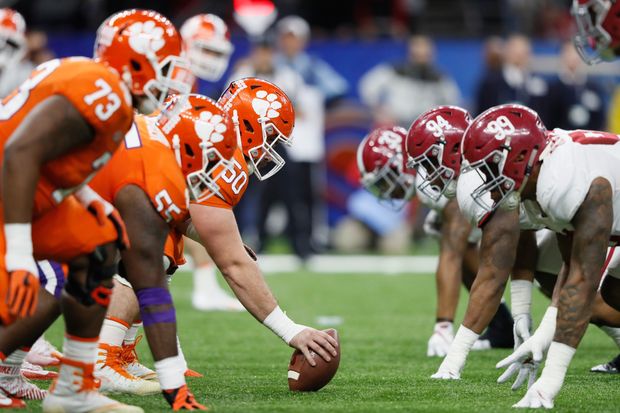
For the third time in four years, the Clemson Tigers and the Alabama Crimson Tide will play for the national championship. PHOTO: JAMIE SQUIRE/GETTY IMAGES
By Rachel Bachman and Brian Costa
Jan. 6, 2019 9:36 a.m. ET
In December 2015, a young man in the Clemson University athletic department received a surprising email. It came from a staff member at Manchester United, the world-famous English Premier League team.
The message: “We want to be more like Clemson.”
For a school whose mention often prompts Google searches for “Where is Clemson?” the email was a huge victory. It came in response to the Tigers’ enhanced social-media efforts to capture the school’s rural location (Clemson, S.C.) and the people who make the football program go.
The email also showed how Clemson, which faces Alabama on Monday in the national championship game for the third time in four years, has climbed into rare air with the Crimson Tide and stayed there. Their formulas: Alabama creates and then exploits its advantages, and Clemson figures out a cheaper, curvier way to get to the same place.
The schools are both in rural southern states with no major pro sports for competition, have a love of football in their DNA and have arguably their best coaches in school history. The Tide have five championships in nine years; Clemson has made the playoff for four years running, won the 2016 season title and lost in the semifinals last season to Alabama.
But they’ve used starkly different strategies to build to their current dominance.
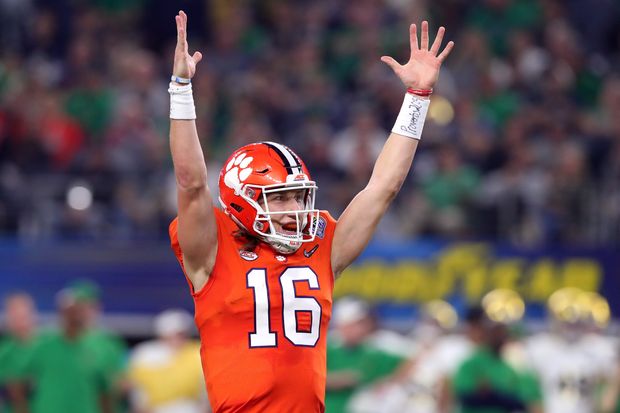
Clemson quarterback Trevor Lawrence reacts after throwing a touchdown pass in Cotton Bowl against Notre Dame.PHOTO: TOM PENNINGTON/GETTY IMAGES
Alabama gets the best recruits. Clemson gets creative.
Over the past five years, the state of Alabama has produced 723 top recruits, according to composite rankings maintained by 247 Sports, which gives each player a rating of one to five stars. That is nearly double the talent pool South Carolina has produced over the same period.
Yet the Tigers have attracted top players from out of state—star quarterback Trevor Lawrence from Georgia and defensive lineman Christian Wilkins from Connecticut, for instance.
The Tigers’ broad reach is partly the byproduct of expanded social-media marketing efforts, spurred by Clemson’s hiring five years ago of a former Tampa Bay Rays employee named Jonathan Gantt to lead a small staff of content creators. Their job: to concoct such vivid portraits of life at Clemson that recruits would want to visit.
View image on Twitter
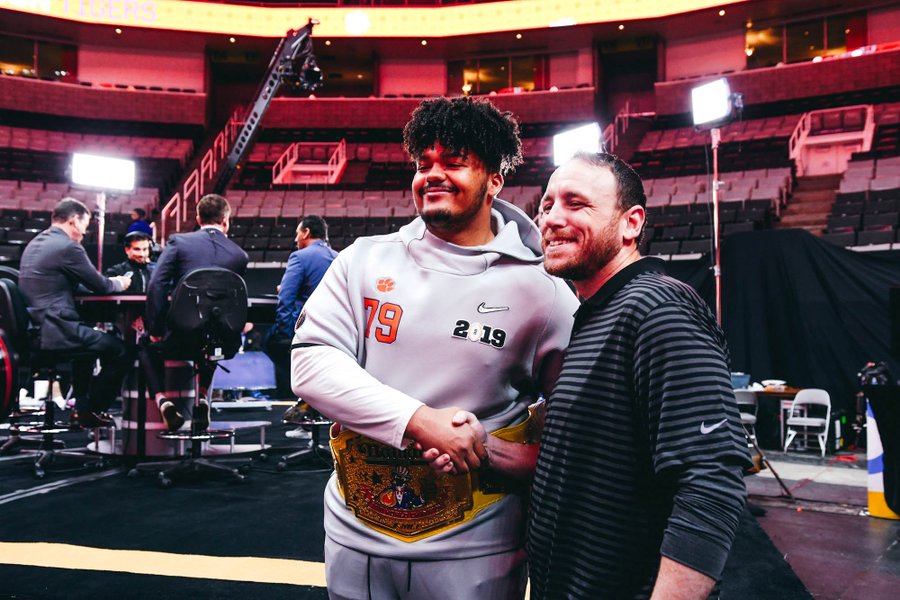
“We wanted to make ours in a much lighter tone and in a much more engaging way focused at teenagers, as opposed to watching a TV show,” Gantt said.
While Alabama remains the king of recruiting—it has had the No. 1-rated class in eight of the past nine years—Clemson’s push is working. A recent poll asked 224 high-school football players to grade their interest in Power 5 conference programs. Alabama was No. 19. The top choice: Clemson.
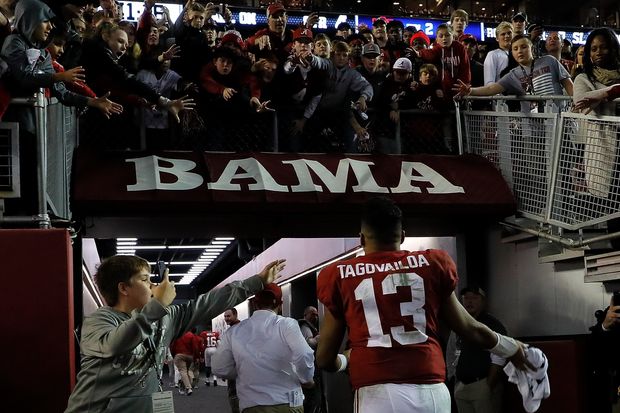
Tua Tagovailoa of the Alabama Crimson Tide leaves the field after a 52-21 win over Auburn on Nov. 24, 2018 in Tuscaloosa, Ala. PHOTO: KEVIN C. COX/GETTY IMAGES
Alabama mints money. The Tigers have to find it in the couch cushions.
In 2017, Alabama generated $108 million from football, more than double the $52 million that Clemson made. Last summer, Alabama announced an upcoming $288 million renovation of 102,000-seat Bryant-Denny Stadium—just eight years after its last stadium expansion.
“We’re never going to out-raise those people,” said Tom Winkopp, a real-estate developer and Clemson booster. “We’re never, ever going to compete with those folks on money.”
Clemson boasts that it was the first to launch an athletics-affiliated fundraising association in 1934, and lately has dreamed up other ways to raise money. More than a decade ago, Winkopp wanted to leverage his contribution to the athletic department and IPTAY, the Clemson fundraising group. So he pledged 1% from the sale of some housing developments to Clemson athletics. In exchange he gets promotional messages at Clemson sporting events.
“How the Grinch *Almost* Stole Clemson’s Signing Day 2018”
It isn’t a windfall in the big picture—Winkopp estimates the arrangement has yielded $1 million for Clemson since 2003—but it helps, and it’s unusual.
“When I got here, that arrangement, that is the first time I had ever heard of something like that,” said Clemson athletic director Dan Radakovich.
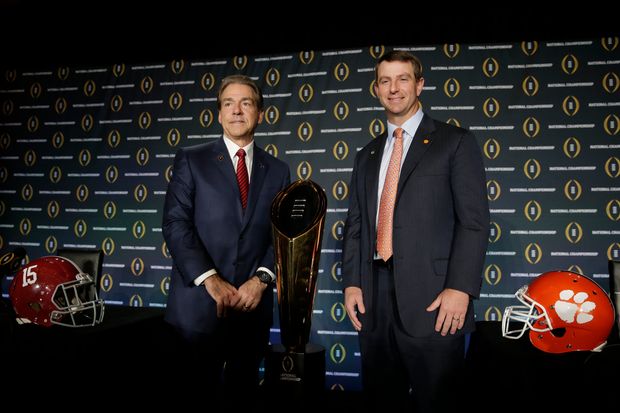
Alabama head coach Nick Saban, left, and Clemson head coach Dabo Swinney have become familiar rivals. PHOTO:CHRIS CARLSON/ASSOCIATED PRESS
Clemson’s head coach has rewarded the school’s patience. Alabama has excelled through impatience.
Swinney came in as a caretaker coach hired after Tommy Bowden resigned midway through the 2008 season. In his second full season, Swinney led the Tigers to a 6-7 record. Though fans pelted then-athletic director Terry Don Phillips with criticism, Phillips backed Swinney.
The Tigers won the ACC title the next season, and have won a Saban-esque 88.7% of their games since 2012. This season, Clemson is 14-0 and has a chance to finish unbeaten for the first time since 1981, when the Tigers won their first and only other national title.
Alabama boosters, on the other hand, had been pining since the 1980s for a coach to match Bear Bryant and his six national titles. Gene Stallings won a national championship in 1992. But no coach after him both measured up and stuck around.
Even more important to the Crimson Tide’s recent dominance than their ongoing investment in facilities has been their refusal to accept middling coaches, said Keith Dunnavant, the author of two books on Alabama football. The four-year run of Mike Shula in the mid-2000s, for instance, brought a .531 winning percentage. Shula was fired.
“In the face of that mediocrity, there’s a lot of angst,” Dunnavant said. “Whereas that mediocrity has been tolerated longer at other places, it wasn’t tolerated at Alabama.”
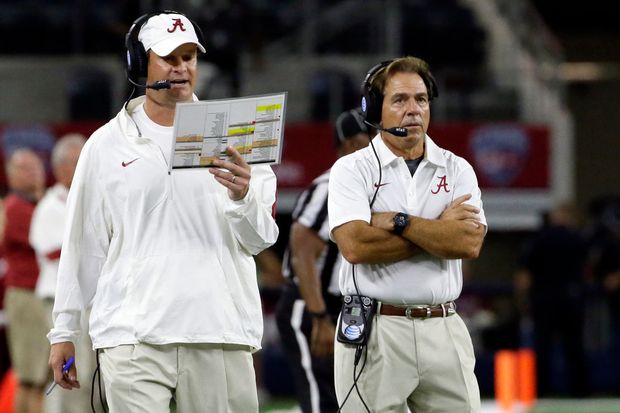
Alabama head coach Nick Saban, right, looks on as then-offensive coordinator Lane Kiffin calls a play on the sidelines during a game in 2015. PHOTO: LM OTERO/ASSOCIATED PRESS
Clemson has longtime assistant coaches. Alabama has guest stars.
Clemson coach Dabo Swinney values stability on his staff so much that he once helped pay for it himself. In 2012, he redirected a portion of his earnings to help fund $450,000 in raises for assistants.
Defensive coordinator Brent Venables has been with the Tigers for seven seasons. Co-offensive coordinators Tony Elliott and Jeff Scott have been at Clemson for eight and 11 seasons, respectively.
“The players that have come in here, they have the same coaches during their time,” Radakovich said. “And that’s always a positive.”
Meanwhile, Saban has churned through assistants, some of whom are trying to rehabilitate their careers after losing higher-level jobs at other programs.
Alabama has had seven offensive or co-offensive coordinators in eight years, including former head coaches at New Mexico, Washington and USC. Saban has referred to former Tennessee head coach Butch Jones, one of 10 football analysts on Alabama’s staff, as an “intern.”
Saban sees value in having assistants who are eyeing better jobs elsewhere—even if that means having to replace them.
“There are coaches that have been in our organization with us and done a phenomenal job,” Saban said. “But they did a phenomenal job and they were motivated because they had personal goals and aspirations for things they wanted to accomplish.”
Write to Rachel Bachman at rachel.bachman@wsj.com and Brian Costa at brian.costa@wsj.com
The Rivalry That Shouldn’t Be: How Clemson Competes With Alabama
The Tigers make 50% less money than the Crimson Tide but recruit and fundraise with creativity
For the third time in four years, the Clemson Tigers and the Alabama Crimson Tide will play for the national championship. PHOTO: JAMIE SQUIRE/GETTY IMAGES
By Rachel Bachman and Brian Costa
Jan. 6, 2019 9:36 a.m. ET
In December 2015, a young man in the Clemson University athletic department received a surprising email. It came from a staff member at Manchester United, the world-famous English Premier League team.
The message: “We want to be more like Clemson.”
For a school whose mention often prompts Google searches for “Where is Clemson?” the email was a huge victory. It came in response to the Tigers’ enhanced social-media efforts to capture the school’s rural location (Clemson, S.C.) and the people who make the football program go.
The email also showed how Clemson, which faces Alabama on Monday in the national championship game for the third time in four years, has climbed into rare air with the Crimson Tide and stayed there. Their formulas: Alabama creates and then exploits its advantages, and Clemson figures out a cheaper, curvier way to get to the same place.
The schools are both in rural southern states with no major pro sports for competition, have a love of football in their DNA and have arguably their best coaches in school history. The Tide have five championships in nine years; Clemson has made the playoff for four years running, won the 2016 season title and lost in the semifinals last season to Alabama.
But they’ve used starkly different strategies to build to their current dominance.
Clemson quarterback Trevor Lawrence reacts after throwing a touchdown pass in Cotton Bowl against Notre Dame.PHOTO: TOM PENNINGTON/GETTY IMAGES
Alabama gets the best recruits. Clemson gets creative.
Over the past five years, the state of Alabama has produced 723 top recruits, according to composite rankings maintained by 247 Sports, which gives each player a rating of one to five stars. That is nearly double the talent pool South Carolina has produced over the same period.
Yet the Tigers have attracted top players from out of state—star quarterback Trevor Lawrence from Georgia and defensive lineman Christian Wilkins from Connecticut, for instance.
The Tigers’ broad reach is partly the byproduct of expanded social-media marketing efforts, spurred by Clemson’s hiring five years ago of a former Tampa Bay Rays employee named Jonathan Gantt to lead a small staff of content creators. Their job: to concoct such vivid portraits of life at Clemson that recruits would want to visit.
View image on Twitter

In August 2017, Clemson launched a video log with a friendly, camera-facing vibe that contrasts with other programs’ “Hard Knocks” documentary-style approach.“We wanted to make ours in a much lighter tone and in a much more engaging way focused at teenagers, as opposed to watching a TV show,” Gantt said.
While Alabama remains the king of recruiting—it has had the No. 1-rated class in eight of the past nine years—Clemson’s push is working. A recent poll asked 224 high-school football players to grade their interest in Power 5 conference programs. Alabama was No. 19. The top choice: Clemson.
Tua Tagovailoa of the Alabama Crimson Tide leaves the field after a 52-21 win over Auburn on Nov. 24, 2018 in Tuscaloosa, Ala. PHOTO: KEVIN C. COX/GETTY IMAGES
Alabama mints money. The Tigers have to find it in the couch cushions.
In 2017, Alabama generated $108 million from football, more than double the $52 million that Clemson made. Last summer, Alabama announced an upcoming $288 million renovation of 102,000-seat Bryant-Denny Stadium—just eight years after its last stadium expansion.
“We’re never going to out-raise those people,” said Tom Winkopp, a real-estate developer and Clemson booster. “We’re never, ever going to compete with those folks on money.”
Clemson boasts that it was the first to launch an athletics-affiliated fundraising association in 1934, and lately has dreamed up other ways to raise money. More than a decade ago, Winkopp wanted to leverage his contribution to the athletic department and IPTAY, the Clemson fundraising group. So he pledged 1% from the sale of some housing developments to Clemson athletics. In exchange he gets promotional messages at Clemson sporting events.
“How the Grinch *Almost* Stole Clemson’s Signing Day 2018”
It isn’t a windfall in the big picture—Winkopp estimates the arrangement has yielded $1 million for Clemson since 2003—but it helps, and it’s unusual.
“When I got here, that arrangement, that is the first time I had ever heard of something like that,” said Clemson athletic director Dan Radakovich.
Alabama head coach Nick Saban, left, and Clemson head coach Dabo Swinney have become familiar rivals. PHOTO:CHRIS CARLSON/ASSOCIATED PRESS
Clemson’s head coach has rewarded the school’s patience. Alabama has excelled through impatience.
Swinney came in as a caretaker coach hired after Tommy Bowden resigned midway through the 2008 season. In his second full season, Swinney led the Tigers to a 6-7 record. Though fans pelted then-athletic director Terry Don Phillips with criticism, Phillips backed Swinney.
The Tigers won the ACC title the next season, and have won a Saban-esque 88.7% of their games since 2012. This season, Clemson is 14-0 and has a chance to finish unbeaten for the first time since 1981, when the Tigers won their first and only other national title.
Alabama boosters, on the other hand, had been pining since the 1980s for a coach to match Bear Bryant and his six national titles. Gene Stallings won a national championship in 1992. But no coach after him both measured up and stuck around.
Even more important to the Crimson Tide’s recent dominance than their ongoing investment in facilities has been their refusal to accept middling coaches, said Keith Dunnavant, the author of two books on Alabama football. The four-year run of Mike Shula in the mid-2000s, for instance, brought a .531 winning percentage. Shula was fired.
“In the face of that mediocrity, there’s a lot of angst,” Dunnavant said. “Whereas that mediocrity has been tolerated longer at other places, it wasn’t tolerated at Alabama.”
Alabama head coach Nick Saban, right, looks on as then-offensive coordinator Lane Kiffin calls a play on the sidelines during a game in 2015. PHOTO: LM OTERO/ASSOCIATED PRESS
Clemson has longtime assistant coaches. Alabama has guest stars.
Clemson coach Dabo Swinney values stability on his staff so much that he once helped pay for it himself. In 2012, he redirected a portion of his earnings to help fund $450,000 in raises for assistants.
Defensive coordinator Brent Venables has been with the Tigers for seven seasons. Co-offensive coordinators Tony Elliott and Jeff Scott have been at Clemson for eight and 11 seasons, respectively.
“The players that have come in here, they have the same coaches during their time,” Radakovich said. “And that’s always a positive.”
Meanwhile, Saban has churned through assistants, some of whom are trying to rehabilitate their careers after losing higher-level jobs at other programs.
Alabama has had seven offensive or co-offensive coordinators in eight years, including former head coaches at New Mexico, Washington and USC. Saban has referred to former Tennessee head coach Butch Jones, one of 10 football analysts on Alabama’s staff, as an “intern.”
Saban sees value in having assistants who are eyeing better jobs elsewhere—even if that means having to replace them.
“There are coaches that have been in our organization with us and done a phenomenal job,” Saban said. “But they did a phenomenal job and they were motivated because they had personal goals and aspirations for things they wanted to accomplish.”
Write to Rachel Bachman at rachel.bachman@wsj.com and Brian Costa at brian.costa@wsj.com
